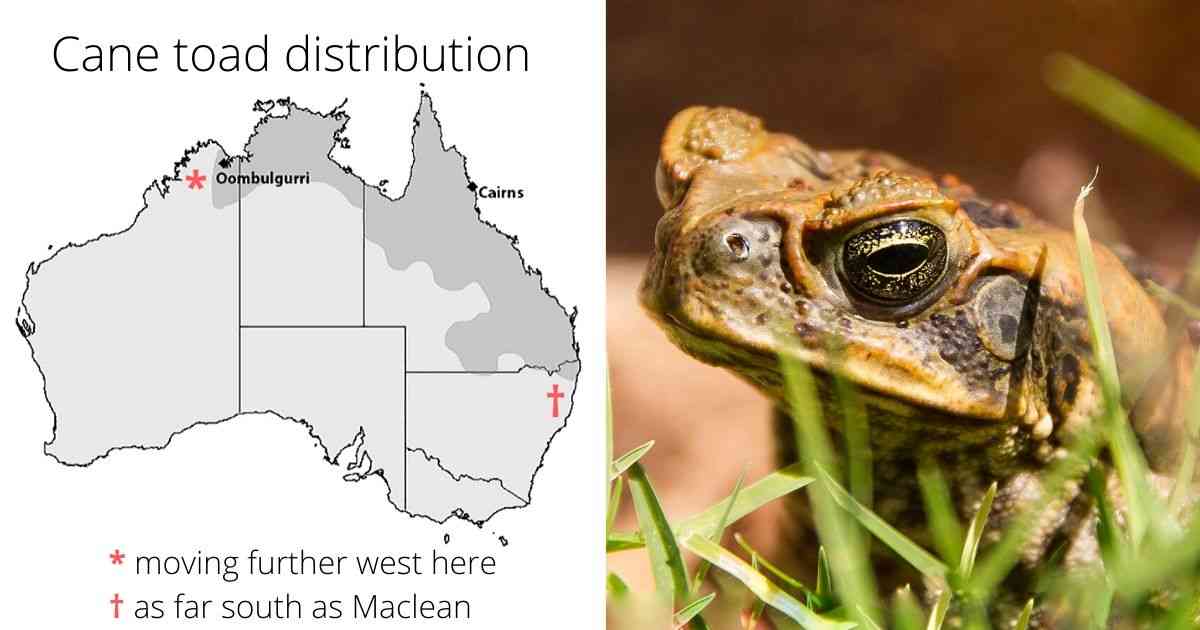Updated March 26, 2021
First aid (details below)
If A Dog Has Cane Toad Poisoning:
- Immediately clean as much toxin from the mouth as possible
- Use wet cloth, paper towel or running water
- Seek veterinary help for all but the mildest cases
Now dive deeper…
If your dog lives in the shaded area on the map, or you plan to go there, then you need to know about cane toads. While most pets are never affected, there are simple things you can do to lower the risk of death.
What Are Cane Toads?
The cane toad (Rhinella marina, formerly Bufo marinus) is a giant, poisonous toad native to Central and South America. In their natural environment I’m sure they have a lot going for them. However, cane toads as an introduced species are a lot harder to love. Here in Australia they’re responsible for a drastic decline in some native animals, and the deaths of pets.
The reason for this is a poison gland behind the eye, which is visible as a broad bulge in the picture above. In fact, this gland is one of the ways you can tell cane toads apart from native frogs (others are the ridge between the nostril and the eye, and the horizontal pupil).
Dogs don’t get poisoned by licking alone, it’s their predatory or inquisitive nature that gets them in trouble. Pressure on the gland by mouthing or biting causes the gland to discharge. The toxin is then absorbed directly from the mouth. and symptoms begin almost immediately.
Signs Of Toad Poisoning
Toads are extremely poisonous to dogs of all sizes. The poison creates both local irritation and systemic effects. Signs that your dog has crossed paths with a toad include:
- Pawing at the mouth and shaking the head
- Profuse drooling and frothing
- Bright red gums
- Eye irritation if poison gets here too
- Vomiting
- Breathing problems
- Unsteady movements
- Seizures
Death can occur within an hour in severe cases.
Treatment Of Toad Poisoning
There is no antidote. Therefore, the first and most important thing is to remove excess toxin. There’s sure to be more still waiting to be absorbed. Your early actions could be lifesaving.
Vets are divided on whether flushing out the mouth with water is a good idea. Some feel there’s too high a risk of getting water in the airways, others feel that the toxin is too sticky to wash out easily. I think there’s not much risk if:
- You’re careful
- Your dog doesn’t fight you
- You don’t point the water towards the throat
Regardless, everyone advises you to wipe out the mouth repeatedly with wet cloth or paper towel. Keep using fresh towel so that you don’t re-wipe toxin back on.
Do you need the vet? If your dog is behaving normally and there’s only minor drooling, it’s probably OK to monitor at home. However, severe salivation, distress, or any signs of illness should have you hurrying to the nearest emergency vet.
Your vet will check the severity of poisoning and place a drip. Then depending on need they may:
- Give drugs to improve the heart rhythm
- Use sedatives or anaesthetics for nervous system signs
- Give oxygen for breathing problems
Toad poison lasts for a few hours but they won’t be completely back to normal for a few days.
Prevention Of Toad Poisoning
Cane toads like warm weather, water and nighttime. Therefore, you need to on your guard during the wet season, especially after dark. Toads are particularly attracted to garden sprinklers, water bowls, swimming pools and outside lighting.
To reduce contact between dogs and toads, follow these tips:
- Cover swimming pools when not in use
- Elevate or move dog water and food bowls
- Keep dogs inside overnight in warm conditions, especially when watering or wet
- Maintain your fencing so that no holes exceed 25mm (1 inch)
- Turn outside lights off when not in use
- Go for regular yard patrols in suitable weather
Toad Poisoning In Cats
Cats are far less likely to be poisoned due to their cautious attitude to prey and food. That’s quite unlike the “try to eat it and see what happens” approach of many dogs. If toxicity occurs, it may look very similar to a dog’s but can also include vomiting, hind leg weakness and a vacant, fixed stare.
Have something to add? Comments (if open) will appear within 24 hours.
By Andrew Spanner BVSc(Hons) MVetStud, a vet in Adelaide, Australia. Meet his team here. The information provided here is not intended to be used as a substitute for going to the vet. If your pet is unwell, please seek veterinary attention.
Image credits: 2017 Australian cane toad range taken from Selechnik, D., West, A. J., Brown, G. P., Fanson, K. V., Addison, B., Rollins, L. A., & Shine, R. (2017). Effects of invasion history on physiological responses to immune system activation in invasive Australian cane toads. PeerJ, 5, e3856.

